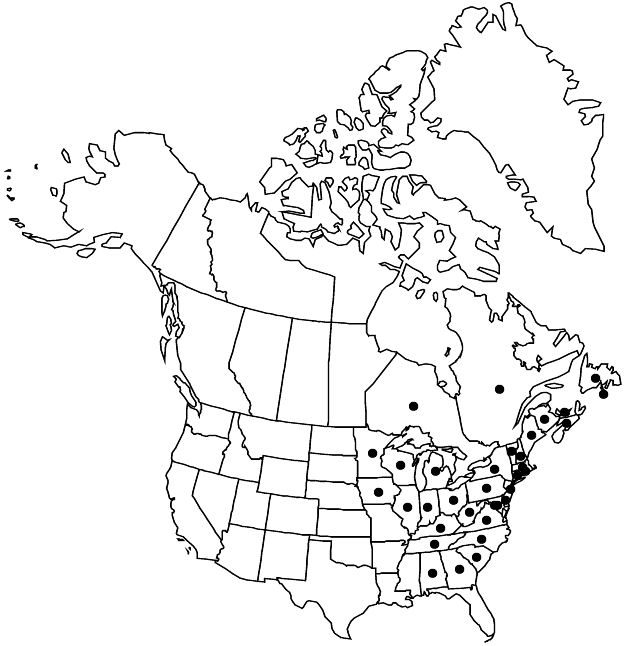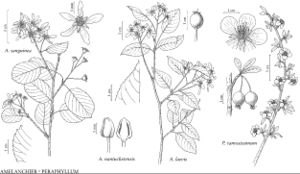Amelanchier laevis
Rhodora 14: 154, plate 96, figs. 7A–G. 1912.
Shrubs or trees, 2–25 m. Stems 1–20, fastigiate, solitary or in colonies. Leaves less than half-unfolded; petiole (7–)15–26(–36) mm; blade elliptic to ovate to oblong or obovate, (32–)48–75(–100) × (19–)29–42(–60) mm, base subcordate to rounded, each margin with (0–)10–23(–38) teeth on proximal 1/2 and (1–)5–9(–13) teeth in distalmost cm, largest teeth less than 1 mm, apex acute to acuminate, abaxial surface glabrous (or sparsely hairy) by flowering, surfaces glabrous later. Inflorescences (4–)7–11(–14)-flowered, (25–)43–65(–85) mm. Pedicels: 0 or 1(or 2) subtended by a leaf, proximalmost (7–)15–28(–41) mm. Flowers: sepals spreading to recurved after flowering, (1.9–)2.8–4(–5.3) mm; petals linear-oblong, (8–)12.5–17.3(–22.5) × (2.9–)3.9–5.7(–7.5) mm; stamens (14–)19–21(–24); styles (4 or)5(or 6), (2.5–)3.3–4.4(–5.3) mm; ovary apex glabrous (or sparsely hairy). Pomes dark purple, 8–15 mm diam. 2n = 2x, 4x.
Phenology: Flowering Apr–Jun; fruiting Jun–Jul.
Habitat: Dry to moist, deciduous, mixed, and coniferous forests, fields, thickets, roadsides
Elevation: 0–2000 m
Distribution

St. Pierre and Miquelon, N.B., Nfld. and Labr. (Nfld.), N.S., Ont., P.E.I., Que., Ala., Conn., Del., D.C., Ga., Ill., Ind., Iowa, Ky., Maine, Md., Mass., Mich., Minn., N.H., N.J., N.Y., N.C., Ohio, Pa., R.I., S.C., Tenn., Vt., Va., W.Va., Wis.
Discussion
Amelanchier laevis is common through much of its range and readily identified by its typically arborescent habit, leaves that are reddish and glabrous by flowering, and relatively long inflorescences, pedicels, and petals. Southeastern United States populations tend to be restricted to high elevations. The relationship to its closest relative, A. arborea, is discussed under the latter.
Amelanchier laevis frequently hybridizes with congeners, including A. arborea, A. bartramiana, A. canadensis, A. humilis, A. interior, A. sanguinea, and A. spicata (M. L. Fernald 1950; L. Cinq-Mars 1971). J. E. Cruise (1964) documented hybrid swarms between A. laevis and both A. arborea and A. canadensis in New Jersey. The hybrid with A. bartramiana can usually be found when these two species grow together (J. E. Weber and C. S. Campbell 1989). The hybrid with A. arborea, A. ×grandiflora Rehder, is used ornamentally.
A. C. Dibble et al. (1998) concluded that Amelanchier laevis is possibly one of the parents of A. "rubra,” an entity that is morphologically distinct. This entity is a tetraploid shrub with stems to 3.5 m and usually colonial, leaves that are reddish and glabrous at flowering, and petals that are often faintly reddish and slightly twisted. Ovary apices are mostly sparsely hairy, but may also be densely hairy or glabrous. Quantitative analysis places A. “rubra” between the cluster of A. laevis plus A. intermedia on the one hand and A. nantucketensis or A. spicata on the other (Dibble et al.). It is possible that this entity could be a hybrid with one of these arborescent species (A. laevis and A. intermedia) plus one of the shrub species (A. nantucketensis and A. spicata). The authors have located populations of A. “rubra” on Mount Desert Island and eastward for about 120 km along the Maine coast. The authors have observed plants that appear to be F1s of this entity and later-generation hybrids with A. bartramiana as one of the parents.
Amelanchier laevis has been documented to be self-compatible and to produce seeds asexually (C. S. Campbell et al. 1985; A. C. Dibble et al. 1998).
Selected References
None.
